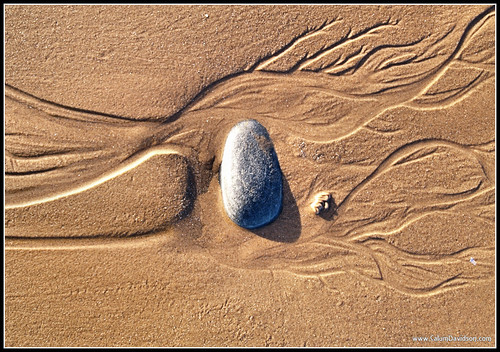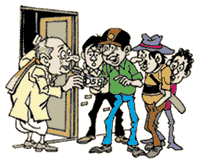Let us enjoy Thiruppavai verse one a day…
Let us meditate on the lotus feet of Sri Godha piraaTTi by enjoying her glories and by reciting her thaniyan before we venture into the verse.
Parasara Bhattar composed this wonderful thaniyan on AndAL…
NeeLA-Tunga sthanagiri-taDI Suptham udhbhOdhya KrishNam
PaarArTyam svam sruthi-satha- siras-siddham adhyApayanthI
svOcchishtAyAm sraji nigalitham yaa balAthkruthya bhunkthE
GOdhA Tasyai Nama idhamidham bhUya yEvAsthu BhUya:
Meaning according to Dr.V.N.S.Raghavan:
May I offer my obeisance again and again to Goddess ANDAL
alias GOdhA --to Her alone--who awakened Lord KrishNA (taking
rest and) sleeping on the mountain-like lofty breasts of
Goddess NILA alias Nappinnai PirAtti; GOdhA , who has
imparted to Him ( Lord KrishNA )Her dependence ( on Him )
as established in the hundreds of the texts of the crown
of the VedAs( Viz. the VedAnthA or the Upanishads); and
GOdhA , who forcefully enjoys Him after binding Him with
flower-wreaths that were already worn by Her.
Relationship of the Taniyan to ThiruppAvai Paasuram
Parasara Bhattar's Taniyan arose from reflections
on " the Kutthu ViLakkeriya" 19th ThiruppAvai Paasuram ,
where ANDAL's PurushakAra prapatthi to NeeLaa Piraatti
is covered.
NeeLA devi has utmost importance in KrishNAvathAram
and AzhwArs have celebrated this sambhandham in their
NaalAyira Dhivya Prabhandhams( NDP):
NamaskAram to ANDAL by ParAsara Bhattar:
" GodhA Tasyai idham idham nama:" To that Godhai ,
all SaasthrA-ordained namaskArams be !
Parasara Bhattar performs PraNAmam to Godhai repeatedly and in many ways.
" BhUya yEvAsthu BhUya :" May those PraNAmams be
repeated in ascending order and be repeated !
Why is GodhA being saluted profusely by Bhattar?
It is because of what She did for us:
(1) She woke up Her Lord , KrishNan (udhbhOdhya KrishNam) ,
who was sleeping blissfully on the vale of the hillock-like
breasts of Nappinnai and instructed (remided)Him (adhyApayaNTHI)
about His sworn duties attested in hundreds of Upanishads
about His Sarva Seshithvam and His Seshi-Sesha relationship
to Jeevans. She became the AchAryan to GeethAchAryan
Himself and reminded Him to wake up and go about His
sworn duties instead of lazing away comfortably
enjoying the Sukham of the lofty breasts of Nappinnai .
(2) She also reminded Him whether He with the name
KrishNan ( Krishir BhUvAchaka: Sabdha Nasccha
nivrutthi Vaachaka:/ You are the One , who gives
aanandham to BhUmi ) . Have You forgotten that
I am Your other consort , BhUmi in ANDAL form
while You rest joyously with NeeLai? She reminded KrishNA
about their Sambhandham ( UtthamUr Swamy's anubhavam).
She questioned Him about His special Moham (infatuation)
for NeeLai , while He should be equally attentive to all
the Three Devis including Herself (" Hreesccha tE
LakshmIsccha Pathnyou" ).
(3) She reminded Him of Her Seshathvam to Him
( Svam PaarArthyam adhyApayanthI) .She reminded
Her Lord that all the chEthanams of the land (BhUmi)
are Sesha BhUthars to Him and that He should wake up
and accept their preethi-poorvaka kaimkaryams and
bless them as their Sarva Seshi. With rights as
the compassionate AchAryan , She instructed Him on
His sworn duties .She is SaakshAth BhUmi PirAtti
(SaakshAth KshamAm --Swamy Desikan ), who pleaded for
the boon of a Laghu UpAyam from Her Lord for us ,
the suffering Jeevans ( VarAha Charama SlOkam ).
That is what She was instructing the Lord about
His relationships and responsibilities ( PaarArdhyam
AdhyApayanthI) in the spirit of "Thvanm mE ,
aham mE" of Bhattar's Thirumanjanakkattiy am , where
the Lord in wet clothes adorned by TuLasi garland
vouches for His sarva Swamithvam to an arrogant jeevan.
This is the Sruthi satha sira siddham PaarArdhyam .
This PaarArdhya Tatthvam is incorporated in the meaning of
Pranavam.This is Sruthi Sira Siddham. She as BhUmi Piratti
( NDP: 614, 1100 and 3772) reminded Her Lord of
this fundamental tatthvam and awakened Him from
His deep slumber to perform His sworn duties.
How did She plead for us ?
She tied Him (Lord KrishNA) down with the TuLasi Maali
that She adorned (svOcchishtAyAm sraji nigaLitham )
and enjoyed Him forcefully ( balAthkruthya BhungthE).
Just as NelA Devi tied down the Lord with Her
Dhivya Soundharyam of Her Tunga Sthana Giri, ANDAL
tied Him down with her TuLasi Maalai and instructed Him
to go about His duties.He was powerless to resist Her
and later married Her and settled down at His
father-in-law' s house at SrivilliputthUr and
stayes there to do His duties.
Taniyan # 2 Uyyakondaar aruLicceythavai)
iruvikaRpa nEricai veNpaa
annavayal puthuvai aaNtaaL * araNGkaRkup
pannu thiruppaavaip palpathiyam * - innicaiyaal
paatikkotuththaaL naRpaamaalai pUmaalai *
cUtik kotuththaaLaic collu.
UyyakkoNDAr visualizes SrivilliputthUr as
a special djivya dEsam , where the Hamsam (Anna
Pakshi) known for its power to separate milk
from water are abundant. It is also a reference
to HamsAvathAra BhagavAn , who instructed BrahmA
on the meanings of Vedams. Parama Hamsa ParivrAjAkAs
also adorn this dhivya desam (Tathra KaashAyiNO VruddhAn--
as stated by Sumanthran in Srimath RaamAyaNam).
She is the Soodikkoduttha NaacchiyAr for Vatapathra Sayee.
She married (garlanded) Sri RanganAthan .Both
garlands of ANDAL are saluted by UyyakkoNDAr .
For Sri RangarAjan , She offered the garland
of ThiruppAvai verses( " ArangaRkkup Pannu ThiruppAvaip
Palpathiyam innisayAl Paadik kodutthAL NaRRppAmalai" ).
For Vatapathra Saayee , She offered TuLasi Maalais
that She adorned and sent with Vaadhyam and parisaram through
the sacred hands of Her father, PeriyAzhwAr. UyyakkoNDAr
asks us to sing about Her (Godhai's) glories
(SoodikkodutthALai sol ).
cUtikkotuththa cutarkkotiyE! * tholpaavai
paati aruLavalla palvaLaiyaay! * - naati nI
vENGkatavaRku ennai vithi enRa immaaRRam *
naam katavaa vaNNamE nalku.
In his first Taniyan, UyyakkoNDAr said that
the Naama SankIrthanam of ANDAL alone is enough
to be blessed. Here, He states that we should also
follow the path shown by Her through Her observance of
Vratham to attain the anugraham of Her Lord.
ANDAL declared : "uRavEl namakku ozhikka ozhiyAthU'
and " Unn tannOdu uRROmEyAvOm, UNAKKE naamm aatccheyvOm" .
UyyakkoNDAr prays to Godhai to bless us to emulate her
and to study and follow the meanings of Her "Thol Paavai".
Godhai's Vaak was "VenakatavaRkku yennai Vithi" ( Make me
the Sesham for Thiru Venkatavan ). UyaakoNDAr prays
to Her to be near Him ( Her Lord)and us so that we can
follow Her path (Maarga darsanam ) without transgression
("imARRAM naam kadavA vaNNam naadi nalhu" ).UyyakkoNDAr
asks Her to come near us with her EmperumAn and help us to
perform this vratham of ThiruppAvai nOnbhu.AchArya Seshathvam
is also implied here.
Dhivya: kanyAvratha Para SudhAsyanthi Sookthi PrabhandhO
Devi GodhA dhadhathu Gurava: Srinidhisccha Sriyam na:
--- (Sri UtthamUr Swamy's PraNAmam to GOdhai)
With her blessings, we will start with the short daily versions of individual Paasurams of ThiruppAvai and enter into this Kaimkaryam.
[Reference: Sri Satakopan Swami's translation of Sri U Ve PerukaraNai Swami's book exhaustive commentary on Thiruppavai]
 ராவணன்: ஸ்ரீ ராமனையே எதிர்த்தான்.
ராவணன்: ஸ்ரீ ராமனையே எதிர்த்தான்.







































